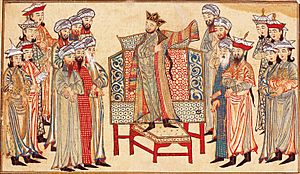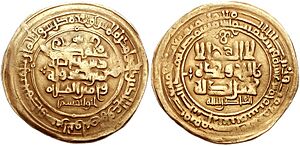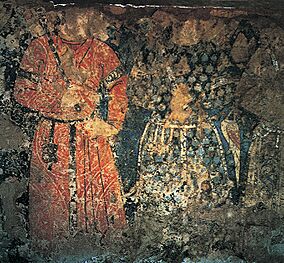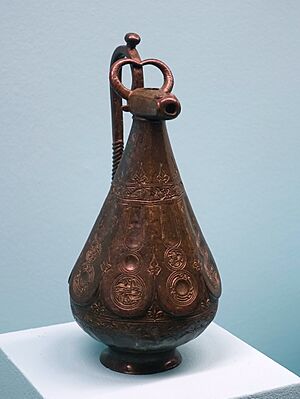Ghaznavids facts for kids
Quick facts for kids
Ghaznavid Empire
غزنویان
Ġaznaviyān |
|||||||||||||||||||||||||||||
|---|---|---|---|---|---|---|---|---|---|---|---|---|---|---|---|---|---|---|---|---|---|---|---|---|---|---|---|---|---|
| 977–1186 | |||||||||||||||||||||||||||||
| Status | Empire | ||||||||||||||||||||||||||||
| Capital | Ghazni (977–1163) Lahore (1163–1186) |
||||||||||||||||||||||||||||
| Common languages | Persian (official and court language; lingua franca) Arabic (theology) Turkic (military) |
||||||||||||||||||||||||||||
| Religion | Sunni Islam Hinduism (majority in India) |
||||||||||||||||||||||||||||
| Government | Hereditary monarchy | ||||||||||||||||||||||||||||
| Sultan | |||||||||||||||||||||||||||||
|
• 977–997
|
Sabuktigin (first) | ||||||||||||||||||||||||||||
|
• 1160–1186
|
Khusrau Malik (last) | ||||||||||||||||||||||||||||
| Vizier | |||||||||||||||||||||||||||||
|
• 998–1013
|
Abu'l-Hasan Isfaraini (first mentioned) | ||||||||||||||||||||||||||||
|
• 12th century
|
Abu'l-Ma'ali Nasrallah (last mentioned) | ||||||||||||||||||||||||||||
| Historical era | Medieval | ||||||||||||||||||||||||||||
|
• Established
|
977 | ||||||||||||||||||||||||||||
|
• Disestablished
|
1186 | ||||||||||||||||||||||||||||
| Area | |||||||||||||||||||||||||||||
| 1029 estimate | 3,400,000 km2 (1,300,000 sq mi) | ||||||||||||||||||||||||||||
|
|||||||||||||||||||||||||||||
The Ghaznavid Empire (Persian: غزنویان Ġaznaviyān) was a powerful Muslim empire that existed from 977 to 1186. It was founded by Turkic soldiers who were once part of another empire. At its largest, the Ghaznavid Empire stretched from the Oxus River to the Indus Valley.
The empire began when Sabuktigin took control of Ghazna. He became the ruler after his father-in-law, Alp Tigin, passed away. Alp Tigin was a former general from the Samanid Empire.
Sabuktigin's son, Mahmud of Ghazni, made the empire much bigger. He expanded it to the Amu Darya and Indus River in the east, and to Rey and Hamadan in the west. However, under Mas'ud I, the Ghaznavids started losing land to the Seljuk Empire. This happened after a big battle called the Battle of Dandanaqan in 1040. After this, their empire was mostly limited to what is now Afghanistan, Pakistan, and Northern India.
In 1151, the city of Ghazni was lost to the Ghurids. The Ghaznavids got it back, but then lost it again to another group called the Ghuzz Turks. Eventually, the Ghurids took Ghazni for good. The Ghaznavids then moved their capital to Lahore. In 1186, the Ghurids conquered Lahore, capturing and later executing the last Ghaznavid ruler, Khusrau Malik. This marked the end of the Ghaznavid Empire.
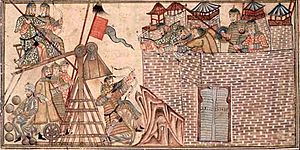
Contents
The Ghaznavid Empire grew from the military forces of the older Samanid Empire. Two important military families, the Simjurids and the Ghaznavids, became very powerful. They were originally Turkic slave-soldiers, known as mamluks.
After the Samanid ruler died in 961, there was a fight over who would rule next. The Samanid generals, including Alp Tigin, wanted to choose the next leader. However, a group of civilian ministers chose someone else. Alp Tigin wisely decided to leave the capital. He moved south and captured the city of Ghazna, becoming its ruler under Samanid authority.
Alp Tigin died in 963. After a few years, his slave-soldier, Sabuktigin, became the governor of Ghazna.
Sabuktigin: The Founder

Sabuktigin started his life as a mamluk, a Turkic slave-soldier. He later married the daughter of his master, Alp Tigin. Alp Tigin had taken control of Ghazna in 962. After Alp Tigin's death, Ghazna had a few rulers. Sabuktigin, using his military skills, eventually became the governor of Ghazna.
Once he was in charge, Sabuktigin helped the Samanid ruler in a campaign. Because of his success, he gained control over several important areas like Balkh and Bamiyan. Sabuktigin also made changes to the way land was given to soldiers, making sure they were always ready to fight.
When Sabuktigin died, he wanted his family to continue ruling. He gave Ghazna to his son, Ismail. His oldest son, Mahmud, felt left out. Mahmud suggested they share power, but Ismail refused. So, Mahmud marched on Ghazna, defeated Ismail in battle in 998, and took control of the city.
Mahmud of Ghazni: The Golden Age
In 998, Mahmud became the ruler. He is the most famous Ghaznavid leader. Under Mahmud, the Ghaznavid Empire reached its peak. He showed his loyalty to the Caliph, the leader of the Muslim world, and was given important titles. Mahmud supported Sunni Islam and fought against other groups. He conquered many territories, including parts of the Samanid Empire and areas in India.
Mahmud led seventeen military expeditions into northern India. His goal was to expand his control and make other states pay tribute to him. These raids also brought back a huge amount of treasure. During his rule, the empire stretched from the borders of Ray to Samarkand, and from the Caspian Sea to the Yamuna River.
Mahmud also settled about 4,000 Turkmen families in Khorasan. However, these Turkmen sometimes raided nearby towns. So, the Ghaznavid governors had to take military action against them.
Conquests in India
Mahmud of Ghazni led many attacks deep into India. He reached cities like Mathura, Kannauj, and Somnath. In 1001, he defeated the Hindu Shahi rulers in the Battle of Peshawar. He also invaded other areas like Multan. In India, the Ghaznavids were often called Turushkas (meaning "Turks").
In 1018, Mahmud attacked and destroyed the city of Mathura. It was a very rich city. According to historical accounts, many idols were burned and destroyed, and gold and silver were taken as loot. In the same year, he captured Kanauj and made the local rulers pay tribute. In 1026, he raided the famous Somnath temple, taking a huge amount of treasure.
The wealth Mahmud brought back from India made Ghazni a magnificent capital. Historians of that time wrote about how grand the city was and how Mahmud supported writers and poets. Mahmud died in April 1030. He chose his son, Mohammed, to be his successor.
Decline of the Empire
Mahmud's Sons and Early Troubles
Mahmud left the empire to his son Mohammed, who was known for being gentle. However, his brother, Mas'ud, wanted more power. Mas'ud fought his brother, won, and became king. He then blinded and imprisoned Mohammed.
Mas'ud struggled to keep the empire together. After a major defeat at the Battle of Dandanaqan in 1040, he lost all the Ghaznavid lands in Persia and Central Asia to the Seljuks. This led to a difficult period for the empire. Mas'ud tried to gather his treasures and rule from India, but his own soldiers stole his wealth. He then made his blind brother, Mohammed, king again. Mas'ud was later killed in 1040.
Mas'ud's son, Madood, then came to Ghazni to claim the throne. He defeated Mohammed's sons. However, the empire continued to fall apart, and many local rulers no longer obeyed Madood. Over the next nine years, four more kings claimed the throne of Ghazni.
Ibrahim: A Period of Peace
In 1058, Ibrahim, another son of Mas'ud, became king. He was a skilled calligrapher and even wrote the Koran himself. Ibrahim brought stability back to the empire. He made a peace agreement with the Seljuks and improved cultural ties.
Under Ibrahim and the rulers who came after him, the empire had a period of calm. Even though it had lost its western lands, it continued to get rich from raids into Northern India. However, they faced strong resistance from Indian rulers. Ibrahim ruled for a long time, until 1098.
Mas'ud III and the Final Years
Mas'ud III ruled for sixteen years without any major problems. He built the Palace of Sultan Mas'ud III and one of the famous Ghazni Minarets. When he died in 1115, the empire showed signs of weakness. There were fights among his sons, and eventually Sultan Bahram Shah became ruler, but he was a vassal (a ruler who owes loyalty to another, more powerful ruler) of the Seljuks.
Sultan Bahram Shah was the last Ghaznavid King to rule Ghazni, their first capital. He ruled for thirty-five years. In 1148, he was defeated in Ghazni by Sayf al-Din Suri. Bahram Shah managed to get the capital back the next year. However, in 1151, a Ghorid King named Ala al-Din Husayn conquered the city. He destroyed Ghazni, burning it for seven days, earning him the nickname "Jahānsuz" (World Burner).
The Seljuks helped Bahram Shah get Ghazni back. But the Ghaznavids continued to struggle with the Ghurids, who slowly took more of their land. Ghazni eventually fell to the Ghurids around 1170.
After Ghazni fell in 1163, the Ghaznavids moved their capital to Lahore. Lahore had been their regional capital in India for a long time. The Ghaznavid rule in northwestern India continued until 1186. That year, the Ghurid sultan, Muhammad of Ghor, conquered Lahore. He captured the last Ghaznavid ruler, Khusrau Malik, and his son. They were later executed in 1191, which ended the Ghaznavid dynasty forever.
Military and Fighting Style
The main part of the Ghaznavid army was made up of Turkic soldiers. They also had thousands of Afghan soldiers from the area south of the Hindu Kush mountains. During Sultan Mahmud's rule, a large new military training center was built in Bost (now Lashkar Gah). This area was known for its blacksmiths who made weapons. After conquering the Punjab region, the Ghaznavids also started to include Hindus in their army.

Indian soldiers, many of whom were Hindu, were an important part of the army. They had their own commander and lived in their own area in Ghazna, where they practiced their religion. These Indian soldiers were very loyal to Mahmud. They were even used to fight against a Turkic rebel, led by a Hindu commander named Tilak.
The Ghaznavid army used military practices similar to those of the Abbasid Caliphate. They also used Arabian horses for quick attacks deep into enemy lands.
Because they had access to the Indus-Ganges plains, the Ghaznavids were the first Muslim army to use war elephants in battle during the 11th and 12th centuries. These elephants were protected by armour plating on their fronts. Using elephants was a new and surprising tactic in other regions where the Ghaznavids fought, especially in Central Asia.
Culture and Legacy
Even though the Ghaznavid dynasty started with Turkic soldiers, it became very Persianised. This means they adopted Persian language, culture, literature, and customs. Many historians consider them a "Persian dynasty."
The Ghaznavid sultans were of Turkic origin, but they quickly adopted Persian ways of ruling and administration. The people who managed the daily running of the state and collected taxes were mostly Persians. They continued the administrative traditions of the Samanids.
Persian literature thrived under the Ghaznavids in the 11th century. The Ghaznavid court was famous for supporting Persian poets. Poets like Farrukhi traveled to work for them. Sultan Mahmud wanted Ghazni to be a center of learning, like Samanid Bukhara. He invited famous scholars and poets, including Ferdowsi and al-Biruni. He even tried to get Avicenna to join his court. Mahmud brought entire libraries to Ghazni, making it a hub of knowledge.
The Ghaznavids also continued the tradition of writing history in Persian. The historian Abu'l-Fadl Bayhaqi wrote his famous Tarikh-e Beyhaqi during this time.
The Ghaznavids became more Persian in their culture than some other Turkic dynasties of their time. They even copied their administrative system from the Samanids.
Some historians in the 16th century tried to connect Sabuktigin's family to ancient Persian kings. However, modern historians believe this was an attempt to link the Ghaznavids to Persia's old history.
Historian Clifford Edmund Bosworth explains that by adopting Persian ways, the Ghaznavids moved away from their original Turkic background. They became deeply connected with the Perso-Islamic culture. As a result, Ghazni became an important center for Arabic learning.
With Sultan Mahmud's invasions of North India, Persian culture spread to Lahore. Lahore became a major Persian cultural center under Ghaznavid rule, attracting scholars from different regions. It was also during Mahmud's reign that Ghaznavid coins started to have writing in both Arabic and Devanagari script. The Ghaznavids helped introduce many Persian customs and ways of governing to India.
The Persian culture established by the Ghaznavids in Ghazna and Eastern Afghanistan lasted even after the Ghurid invasion in the 12th century, continuing until the Mongol invasion.
Impact and Legacy
At its peak, the Ghaznavid Empire stretched from the Oxus River to the Indus Valley, ruling from 977 to 1186. Historians like Abu Nasr al-Utbi wrote about the Ghaznavids' achievements, including how they regained land from rivals like the Kara-Khanid Khanate.
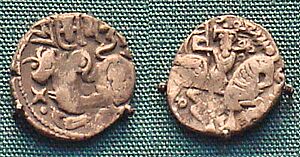
Besides the wealth gained from raiding Indian cities and collecting tribute from Indian rulers, the Ghaznavids also benefited from their location. They were an important link along the trade routes between China and the Mediterranean Sea. The Ghaznavid rulers are generally seen as important figures in spreading Islam into the Indian subcontinent.
However, they could not hold onto their power for long. By 1040, the Seljuk Empire had taken over their lands in Persia. A century later, the Ghurids took over their remaining territories in India.
The Ghaznavid conquests helped start the Turko-Afghan period in India. This period continued with the Ghurids, who eventually established the Delhi Sultanate.
List of Rulers
| # | Laqab | Personal Name | Reign | Succession right | Notes |
|---|---|---|---|---|---|
| 1 | Nasir-ud-din
نصر الدين |
Sabuktigin | 977–997 | ||
| 2 | No title | Ismail | 997–998 | son of Sabuktigin | |
| 3 | Yamin ad-Dawlah Abu Qasim یمین الدولہ ابو لقاسم Right-hand man of the State |
Mahmud | 998–1030 | first son of Sabuktigin | |
| 4 | Jalal ad-Dawlah جلال الدولہ Dignity of the State |
Muhammad | 1030 1st reign |
second son of Mahmud | |
| 5 | Shihab ad-Dawlah شھاب الدولہ Star of the State |
Masud I | 1030–1041 | first son of Mahmud | Was overthrown, imprisoned and executed, following the battle of Dandanaqan |
| — | Jalal ad-Dawlah جلال الدولہ Dignity of the State |
Muhammad | 1041 2nd reign |
second son of Mahmud | Raised to the throne following the removal of Masud I. |
| 6 | Shihab ad-Dawlah شھاب الدولہ Star of the State |
Mawdud | 1041–1048 | son of Masud I | Defeated Muhammad at the battle of Nangrahar and gained the throne. |
| 7 | ? ? |
Masud II | 1048 | son of Mawdud | |
| 8 | Baha ad-Dawlah بھاء الدولہ Splendor of the State |
Ali | 1048–1049 | son of Masud I | |
| 9 | Izz ad-Dawlah عز الدولہ Glory of the State |
Abd al-Rashid | 1049–1052 | fifth son of Mahmud | |
| 10 | Qiwam ad-Dawlah قوام الدولہ Support of the State |
Toghrul | 1052–1053 | Turkish mamluk general | Usurped the Ghaznavid throne after massacring Abd al-Rashid and eleven other Ghaznavid princes. |
| 11 | Jamal ad-Dawlah جمال الدولہ Beauty of the state |
Farrukh-Zad | 1053–1059 | son of Masud I | |
| 12 | Zahir ad-Dawlah ظھیر الدولہ Help of the State |
Ibrahim | 1059–1099 | son of Masud I | |
| 13 | Ala ad-Dawlah علاء الدولہ Blessing of the State |
Mas'ūd III | 1099–1115 | son of Ibrahim | |
| 14 | Kamal ad-Dawlah کمال الدولہ Perfection of the State |
Shir-Zad | 1115–1116 | son of Masud III | Murdered by his younger brother Arslan ibn Mas'ud. |
| 15 | Sultan ad-Dawlah سلطان الدولہ Sultan of the state |
Arslan-Shah | 1116–1117 | son of Masud III | Took the throne from his older brother Shirzad, but faced a rebellion from his other brother Bahram Shah, who was supported by the sultan of the Great Seljuq Empire, Ahmad Sanjar. |
| 16 | Yamin ad-Dawlah یمین الدولہ Right-hand man of the state |
Bahram Shah | 1117–1157 | son of Masud III | Under Bahram-Shah, the Ghaznavid empire became a tributary of the Great Seljuq Empire. Bahram was assisted by Ahmad Sanjar, sultan of the Great Seljuq empire, in securing his throne. |
| 17 | Muizz ad-Dawlah معزالدولہ Honor of the State |
Khusrau Shah | 1157–1160 | son of Bahram-Shah | |
| 18 | Taj ad-Dawlah تاج الدولہ Crown of the state |
Khusrau Malik | 1160–1186 | son of Khusrau-Shah |
|
|||||||||||||||||||||||||||||||||||||||||||||||||||||||||||||||||||||||||||||||||||||||||||||||||||||||||||||||||||||||||||||||||||||||||||||||||||||||||||||||||||||||||||||||||||||||||||||||||||||||||||||||||||||||||||||||||||||||||||||||||||||||||||||||||||||||||||||||||||||||||||||||||||||||||||||||||||||||||||||||||||||||||||||||||||||||||||||||||||||||||||||||||||||||||||||||||||||||||||||||||||||||||||||||||||||||||||||||||||||||||||||||||||||||||||||||||||||||||||||||||||||||||||||||||||||||||||||||||||||||||||||||||||||||||||||||||||||||||||||||||||||||||||||||||||||||||||||||||||||||||||||||||||||||||||||||||||||||||||||||||||||||||||||||||||||||||||||||||||||||||||||||||||||||||||||||||||||||||||||||||||||||||||||||||||||||||||||||||||||||||||||||||||||||||||||||||||||||||||||||||||||||||||||||||||||||||||||||||||||||||||||||||||||||||||||||||||||||||||||||||||||||||||||||||||||||||||||||||||||||||||||||||||||||||||||||||||||||||||||||||||||||||||||||||||||||||||||||||||||||
Notes:
|
|||||||||||||||||||||||||||||||||||||||||||||||||||||||||||||||||||||||||||||||||||||||||||||||||||||||||||||||||||||||||||||||||||||||||||||||||||||||||||||||||||||||||||||||||||||||||||||||||||||||||||||||||||||||||||||||||||||||||||||||||||||||||||||||||||||||||||||||||||||||||||||||||||||||||||||||||||||||||||||||||||||||||||||||||||||||||||||||||||||||||||||||||||||||||||||||||||||||||||||||||||||||||||||||||||||||||||||||||||||||||||||||||||||||||||||||||||||||||||||||||||||||||||||||||||||||||||||||||||||||||||||||||||||||||||||||||||||||||||||||||||||||||||||||||||||||||||||||||||||||||||||||||||||||||||||||||||||||||||||||||||||||||||||||||||||||||||||||||||||||||||||||||||||||||||||||||||||||||||||||||||||||||||||||||||||||||||||||||||||||||||||||||||||||||||||||||||||||||||||||||||||||||||||||||||||||||||||||||||||||||||||||||||||||||||||||||||||||||||||||||||||||||||||||||||||||||||||||||||||||||||||||||||||||||||||||||||||||||||||||||||||||||||||||||||||||||||||||||||||||
See also
- List of battles involving the Ghaznavid Empire
- History of Afghanistan
- History of Pakistan
- List of Sunni Muslim dynasties



